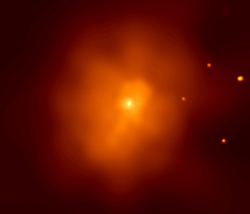September 6, 2001
RELEASE: 01-180
Astronomers have shed new light on dark matter, the invisible and unknown material that comprises most of the universe.
Using NASA's Chandra X-ray Observatory, scientists have precisely determined the distribution of dark matter in a distant galaxy cluster. These new measurements serve to narrow the field of candidates that explain this puzzling element.
John Arabadjis and Mark Bautz of the Massachusetts Institute of Technology (MIT) in Cambridge, Mass., and Gordon Garmire of Pennsylvania State University (Penn State) in University Park, announced their results today at the "Two Years of Science with Chandra" symposium in Washington. Their observations enabled them to trace the distribution of dark matter in the galaxy cluster EMSS 1358+6245.
Previous evidence from radio, optical and X-ray observations convinced astronomers that most of the matter in the universe is in some dark, as yet undetected, form that makes its presence felt only through gravity. "The new Chandra observations are providing new clues about the nature of this mysterious stuff," said Bautz.
"When combined with data from the Hubble Space Telescope, we are able to place restrictions on the cross section, or size, of the dark matter particles," said Arabadjis. "The larger the particles, the more strongly they interact, and the more they alter the dark matter distribution."
In galaxy clusters, the amount of dark matter can be inferred by measuring the pressure in hot gas that emits X-rays. Astronomers can then determine how much dark matter would be required to provide the gravity necessary to keep the gas from escaping the cluster. In the cluster EMSS 1358+6245, the mass of the dark matter is found to be about four times that of the "normal" matter (matter not comprised of exotic particles), typical of large galaxy clusters. The distribution of dark matter holds the key to understanding its composition.
The most popular model for dark matter invokes slowly moving particles called cold dark matter, which interact with "normal" matter only through gravity. Recent optical observations of galaxies and galaxy clusters have suggested that dark matter particles may interact more vigorously than simple cold dark matter. The problem is that galaxies composed primarily of cold dark matter should have a greater central concentration of dark matter than the optical data suggest.
One solution has been to introduce the concept of "self-interacting dark matter." By comparing the Chandra data with theoretical simulations, scientists can place strict constraints on these particles. Chandra observations show there is no evidence for an excessively spread-out dark matter distribution at distances larger than 150,000 light years from the cluster's center. Inside that distance the dark matter may be rather uniformly distributed, so some collisions between dark matter particles may still be needed. These results over a range of distances from the cluster center place the strongest observational limits yet on the dark matter interaction rate in galaxy cluster cores.
Chandra observed EMSS 1358+6245, about 4 billion light years away in the constellation Draco, for more than 15 hours on Sept. 3-4, 2000, using the Advanced CCD Imaging Spectrometer.
Penn State and MIT developed the instrument for NASA. NASA's Marshall Space Flight Center in Huntsville, Ala., manages the Chandra program, and TRW, Inc., Redondo Beach, Calif., is the prime contractor for the spacecraft. The Smithsonian's Chandra X-ray Center controls science and flight operations from Cambridge, Mass.
Images associated with this release are available on the World Wide Web at:
MEDIA CONTACTS
Dolores Beasley
Headquarters, Washington, DC
Phone: 202/358-1753
Steve Roy
Marshall Space Flight Center, Huntsville, AL
Phone: 256-544-6535
Megan Watzke
Chandra X-ray Observatory Center, CfA, Cambridge, MA
Phone: 617-496-7998



